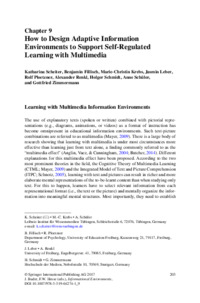How to Design Adaptive Information Environments to Support Self-Regulated Learning with Multimedia |
 |
 Diese Seite wurde seit 2 Jahren inhaltlich nicht mehr aktualisiert.
Unter Umständen ist sie nicht mehr aktuell.
Diese Seite wurde seit 2 Jahren inhaltlich nicht mehr aktualisiert.
Unter Umständen ist sie nicht mehr aktuell.
 Zusammenfassungen
Zusammenfassungen
 Chapter 9 (Scheiter et al., 2017) focuses on the support of self-regulated learning
(cognitive perspective) through an adaptive multimedia environment (socialinteractive
perspective). The chapter describes various studies in which information
processing of learners was captured through tracking of a learner’s eye movements
and through rapid, online assessments of current knowledge. Based on these
assessments, the multimedia environment could then adapt to the situational needs
of the learner. The system provided both directive adaptivity (automatic changes
in the design of the learning environment) and assistive adaptivity (displaying
instructional prompts that help to improve self-regulation skills).
Chapter 9 (Scheiter et al., 2017) focuses on the support of self-regulated learning
(cognitive perspective) through an adaptive multimedia environment (socialinteractive
perspective). The chapter describes various studies in which information
processing of learners was captured through tracking of a learner’s eye movements
and through rapid, online assessments of current knowledge. Based on these
assessments, the multimedia environment could then adapt to the situational needs
of the learner. The system provided both directive adaptivity (automatic changes
in the design of the learning environment) and assistive adaptivity (displaying
instructional prompts that help to improve self-regulation skills). Multimedia materials have become an important component of digital information environments. In general, they have been shown to foster student learning; however, many students fail to process the materials in ways that lead to deeper understanding. This can be regarded as a deficit in students´ self-regulation. That is, many students do not adequately monitor their level of understanding and do not apply cognitive processes that would contribute to better learning. Modern educational technology allows supporting learners by designing information environments that—rather than offering a one-size-fits-all support—are adapted to the degree to which students face learning problems. In particular, adaptive learning environments facilitate (continuous) self-assessment of the students´ learning processes as well as the knowledge they acquire, thereby supporting monitoring. In addition, they improve regulation of learning processes by giving instructional guidance that is adjusted to what is needed by a particular student in a specific situation. In the present contribution, we describe a multimedia learning environment that monitors the students´ learning by registering and analyzing their eye movements and their knowledge by means of rapid assessment tasks. Moreover, the learning environment offers either assistive or directive adaptivity to support them (e.g., instructional prompts, changes in the design of the learning materials). We discuss challenges regarding the design of the adaptive (multimedia) learning environment that refer to the assessment of learning deficits as well as the choice of interventions aimed at overcoming these deficits.
Multimedia materials have become an important component of digital information environments. In general, they have been shown to foster student learning; however, many students fail to process the materials in ways that lead to deeper understanding. This can be regarded as a deficit in students´ self-regulation. That is, many students do not adequately monitor their level of understanding and do not apply cognitive processes that would contribute to better learning. Modern educational technology allows supporting learners by designing information environments that—rather than offering a one-size-fits-all support—are adapted to the degree to which students face learning problems. In particular, adaptive learning environments facilitate (continuous) self-assessment of the students´ learning processes as well as the knowledge they acquire, thereby supporting monitoring. In addition, they improve regulation of learning processes by giving instructional guidance that is adjusted to what is needed by a particular student in a specific situation. In the present contribution, we describe a multimedia learning environment that monitors the students´ learning by registering and analyzing their eye movements and their knowledge by means of rapid assessment tasks. Moreover, the learning environment offers either assistive or directive adaptivity to support them (e.g., instructional prompts, changes in the design of the learning materials). We discuss challenges regarding the design of the adaptive (multimedia) learning environment that refer to the assessment of learning deficits as well as the choice of interventions aimed at overcoming these deficits. Dieses Kapitel erwähnt ...
Dieses Kapitel erwähnt ...
 Begriffe KB IB clear | cognitive load theory (CLT) |
 Anderswo finden
Anderswo finden
 Volltext dieses Dokuments
Volltext dieses Dokuments
 |  How to Design Adaptive Information Environments to Support Self-Regulated Learning with Multimedia: Artikel als Volltext bei Springerlink ( How to Design Adaptive Information Environments to Support Self-Regulated Learning with Multimedia: Artikel als Volltext bei Springerlink ( : :  , 199 kByte; , 199 kByte;  : :  ) ) |
 Anderswo suchen
Anderswo suchen 
 Beat und dieses Kapitel
Beat und dieses Kapitel
Beat hat Dieses Kapitel während seiner Zeit am Institut für Medien und Schule (IMS) ins Biblionetz aufgenommen. Beat besitzt kein physisches, aber ein digitales Exemplar. Eine digitale Version ist auf dem Internet verfügbar (s.o.). Aufgrund der wenigen Einträge im Biblionetz scheint er es nicht wirklich gelesen zu haben. Es gibt bisher auch nur wenige Objekte im Biblionetz, die dieses Werk zitieren.










 Biblionetz-History
Biblionetz-History